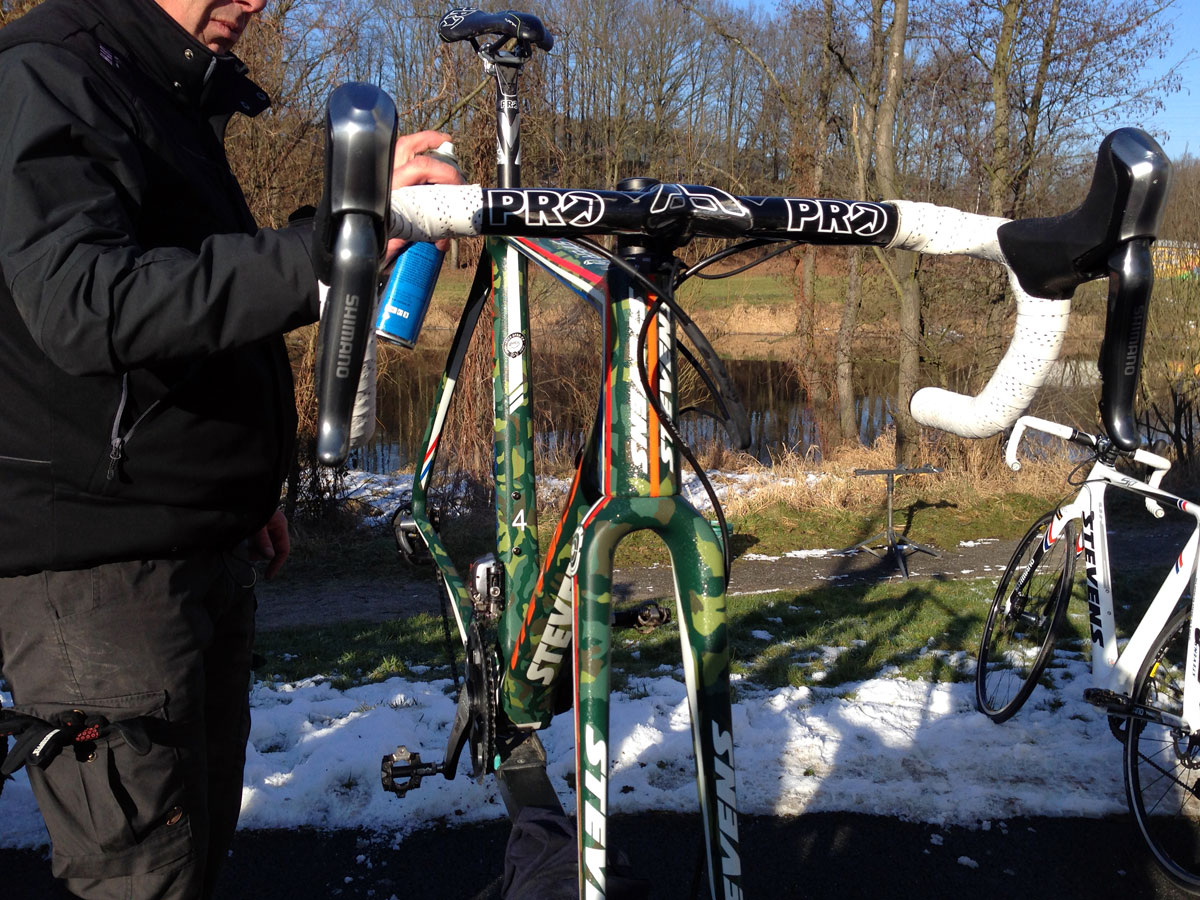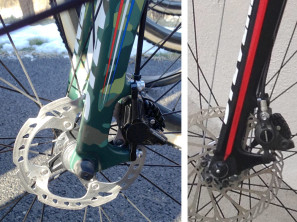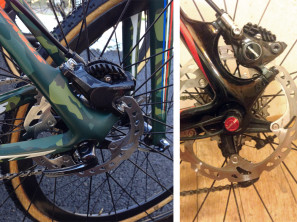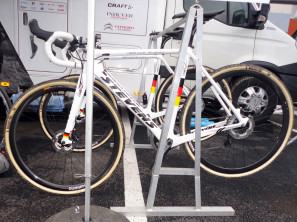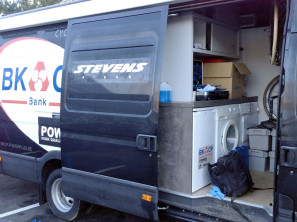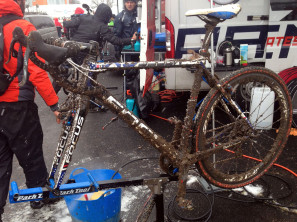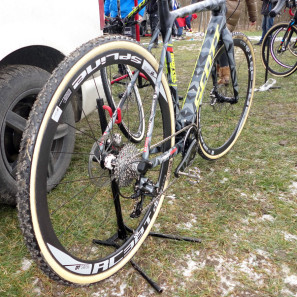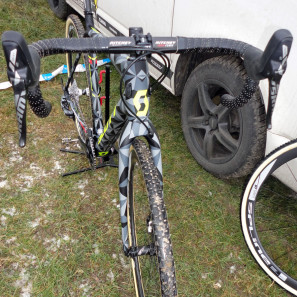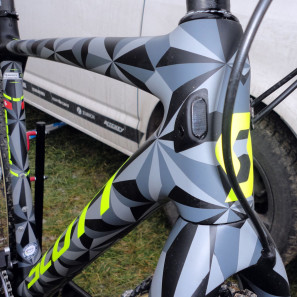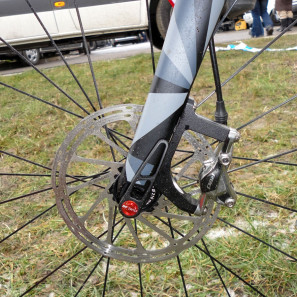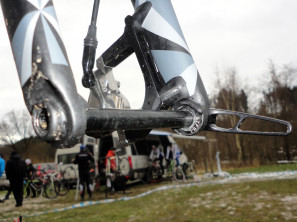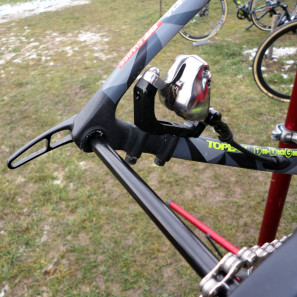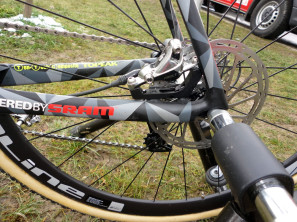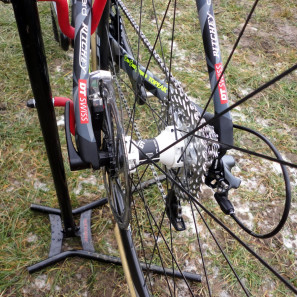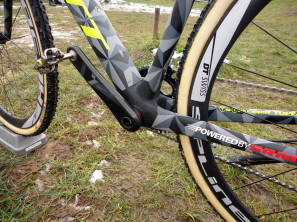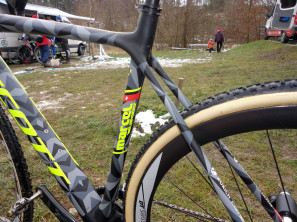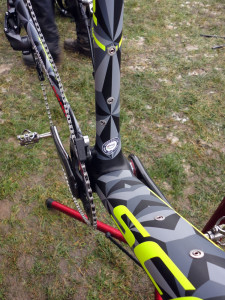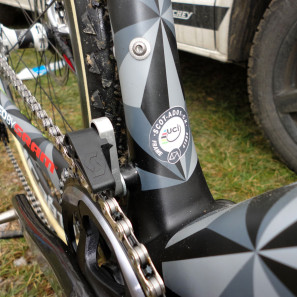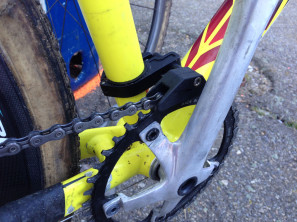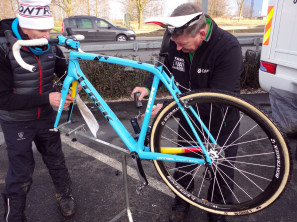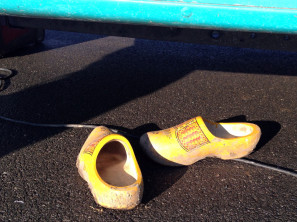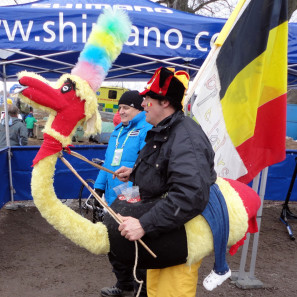We’re back for another roundup of tech details from last weekend’s Cyclocross Worlds in Tábor. Today we’ll start off with the bike of young Dutchman and new world champ Mathieu van der Poel, as he kept a couple of mechanics busy going over his four prototype bikes in prep for Sunday’s big race. The biggest secret we could weasel out of them was probably their heavy use of spray-on wax polish. Besides making frames, helmets, and shoes look sparkly and new, it also does a bit to keep mud from sticking and certainly makes it easier to quickly wash the mud off that does build-up on the bike.
Read on for part two, where we’ll look a bit more behind the scenes at the prep for the final elite men’s race…
While we’ve seen some pretty good coverage of van der Poel’s custom camouflage sniper and Dutch champion themed bikes, after Stevens proudly sent around press releases, what wasn’t really noted was the prototype nature of the frame and fork themselves. Since we had been riding the same bike all season, we were curious to notice that van der Poel was riding 140mm discs. Like we had mentioned in our recent review, we thought it was a shame that the top-level cross race bike was stuck with 160mm rotors. It seems Stevens realized this too, and the Dutchman’s bike had a reworked fork and frame, both tucking in the post-mount calipers lower and closer to the leg/stay. It is a very welcome change that we’ll guess will make its way onto the 2016 bikes, bringing compatibility with either 140 or 160mm rotors.
It seems that there aren’t too many of the new prototype frames out in the world yet, as ex-German champ Philipp Walsleben was riding 160mm disc frames with the new 140mm forks for the better front brake modulation. Walsleben also got a new national champion-themed bike at the beginning of the year with Stevens Bikes taking over sponsorship of BKCP-Powerplus, but he will have to wait until next season for little rotors on his frame.
Walsleben’s bike was sitting in front of his trade team BKCP-Powerplus’ vehicles, which in the confusion of World Championships also housed the Belgian team’s official mechanic. Their team van was about as pro cyclocross as you can get, with a refrigerator and washer/dryer mixed in with an assortment of carbon tubulars and several bikes, all fit into a standard sprinter van. How do we get one of these for our amateur races? I guess we’ll need to talk to Mercedes or Westfalia about sending one over for a long-term test next cross season.
Walking back past Tom Hopper, we wondered why with as much mud as we were seeing on bikes, we still weren’t seeing more disc-brake bikes from the men. There of course still seems to be a bit of resistance to change, but Hopper pointed to the practicality. The Tábor course, while very slippery only had maybe one location where you could approach a hard turn at really high speed and needed to slow quickly. Generally there just wasn’t a lot of need for hard braking on the course, and in the end he thought with the slick conditions, the riders were actually benefiting from less braking power. (It’s interesting to note of course that both the men’s and women’s elite winners were riding disc brakes, but both had 140mm rotors which still are not so common.)
After the first races had already started for the weekend we got a heads up from Scott and posted about their return to making top-end cross bikes. We searched out Marcel Wildhaber early Sunday morning to see if we could get a look at the bike in person. In a bit of the beauty of the approachability of cyclocross, we asked the most Swiss looking group of fans we could find if they had seen Wildhaber (since we couldn’t find him on Saturday.) It turned out that his mother was in the small group we asked and pointed us in the right direction. Even better when I found his bikes and told his mechanic that Mrs. Wildhaber had sent me, he said, “Oh, that’s my mom.” It turns out Patrick Wildhaber was wrenching on brother Marcel’s bikes for Worlds. Cyclocross: a family affair.
Anyway, Patrick showed us a bunch of features on the new bikes, which they had only had for about 2 weeks. First, they were newly riding the same DT Swiss RC38 that we have been testing this season along with the Super Prestige, but hadn’t really had enough time to offer any new insight. The bike does have modular internal routing to accommodate a standard 2x drivetrain, but with SRAM CX1 they had just duct-taped over the port until Scott comes out with a closed port to fill the empty hole. Front brake routing is through the fork leg, which keeps the hose in check, but makes that first install a lot more difficult, and left a big enough gap around the brake line that Wildhaber filled in all three of the new bikes with black silicone. Not an overly elegant solution, but functional. Hopefully Scott will provide a tight fitting rubber seal by the time this hits production.
The bike does have thru-axles front and rear that use the DT RWS spin-to-tighten axles. It looked like the front used a 15mm axle (although we couldn’t measure it) and the rear was actually labeled on the hanger as 12x142mm. The dropouts are nicely hooded, so the wheels should drop in nicely for quick wheel swaps. Brakes are mounted front and rear with the (re)new Shimano flat mount standard, which although it looks like it adds a bit of extra weight in an extra set of bolts and a big aluminum adapter, at least it means the bike can run smaller 140mm rotors if you so choose.
After having just struggled with a DT Swiss RWS on a couple of bikes recently, it is nice to see that there should be plenty of room to spin that lever around on this non-driveside dropout. As for the bottom bracket, it looks like the PF86 that shows up on the road-going Addicts, and the lack of a chainstay bridge or shelf should do well for mud clearing. The seatstays are relatively thin and widely spaced which again should be good in the mud and maybe offer a forgiving ride.
Tubing shapes look to be similar overall to the Addict SL, and with the abbreviation on the UCI frame sticker, it is likely to stick with the previous generation’s naming as Addict CX or even evolve to Addict CX SL. There are a generous assortment of unused bosses on the frame, including 2 pairs of bottle bosses, a pair of bosses to bolt on a front derailleur mount, and even a taped off port in the back of the seattube that is presumably for an internally routed front derailleur wire. Lastly there is a nice looking Scott-branded chain keeper. After the number of chain derailments we’ve seen in cross due to the ease of accidentally tapping Di2 buttons while carrying the bike or being overconfident in the tensioning capabilities of a CX1 derailleur, it is nice to see some proper bolt-on chain security.
With chain security in my head, I happened to notice that even one of the pit bikes I saw running around (and old Empella if I recall) had a bolt-on chain keeper. While we have had fine luck this year adding road-style chain guides to bikes with front derailleurs, if we try any 1x drivetrains in cross next year, they will definitely get an over-the-top guide like this.
We’ll end the cross tech with a quick view of Sven Nys’ custom painted Trek Boone (and stem.) As we were heading home for the weekend, the Crelan mechanics were still working on the Cannibal from Baal’s bikes, finishing up cleaning, and lubing those prototype pedals for the next race.
And don’t forget a couple of cyclocross lessons we learned along the way this past weekend: 1. You can tell if your pro cyclocross mechanic is truly Dutch if they use a set of wooden clogs (Klompen) as pit boots, and 2. In Europe it isn’t always easy to find a cup holder for your beers, so sometimes it is best to bring your own. OK, with that we’ll finish race tech coverage.
Keep your eyes open, as we still have a lot of long-term cyclocross and gravel/dirt road cross-over gear to cover from Europe in the next couple of months before we switch back to dry road and mountain bike riding when spring comes around.
